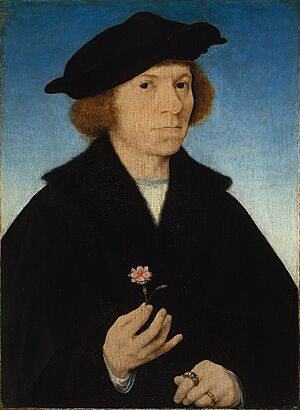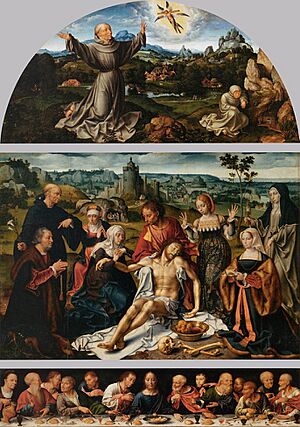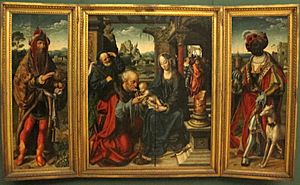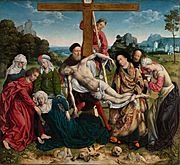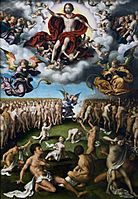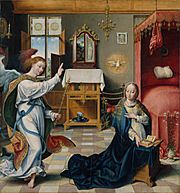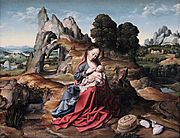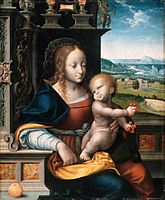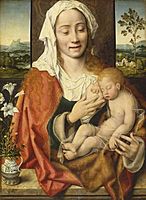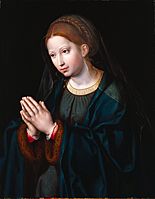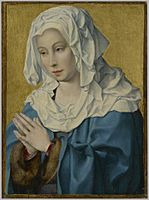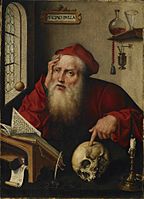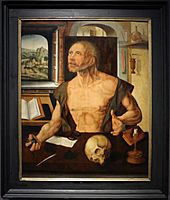Joos van Cleve facts for kids
Joos van Cleve (born around 1485–1490, died 1540 or 1541) was a very important painter. He worked in Antwerp, a city in what is now Belgium. He arrived there around 1511 and painted until his death. Joos van Cleve combined older painting styles from the Netherlands with newer Renaissance art ideas.
He was an active member of the Guild of Saint Luke in Antwerp, which was a group for artists. He is best known for his religious paintings and portraits, including some of kings and queens. Joos van Cleve ran a large workshop. He had at least five students and other helpers. They created many paintings in different styles over the years.
He was a skilled artist who used colors beautifully. His paintings often showed strong figures. His style was very varied. He was one of the first artists to paint wide, open landscapes in the backgrounds of his works. Sometimes he even worked with another painter, Joachim Patinir, on these landscapes. This became a popular style in northern European paintings during the 1500s. Some of his art looked like the popular Antwerp Mannerism style. Other works were similar to older Dutch masters or newer Italian paintings.
Four of his most important paintings have a small "JB" mark. This likely stands for Joos van der Beke, which was his real name. In three other paintings, he included a small self-portrait among the other figures. For a long time, from the 1600s to the 1800s, people forgot Joos van Cleve's name. Some of his paintings were known as works by the "Master of the Death of the Virgin." This was because of a large painting in a museum in Cologne. In 1894, people discovered that the "JB" mark on the back of that painting belonged to Joos van der Beke. Later, in the 1920s and 1930s, art experts put together a list of over 300 works now believed to be by him or his workshop.
Joos van Cleve was the father of Cornelis van Cleve (1520–1567). Cornelis also became a painter and took over his father's workshop. Sadly, Cornelis became mentally ill while living in England. Because of this, people called him 'Sotte Cleef', which means 'mad Cleef'.
Contents
Joos van Cleve's Life Story
Joos van Cleve was born around 1485 to 1490. We don't know his exact birthplace. In official papers from Antwerp, he was called 'Joos van der Beke alias van Cleve'. This probably means he came from the city of Kleve (also called "Cleves") in Germany. It is thought that he started learning to paint around 1505. He likely trained in the workshop of Jan Joest. He helped Jan Joest paint large altarpieces for a church in Kalkar, Germany, from 1506 to 1509. One of these altarpieces even includes a self-portrait of Joos. This helps us guess his birth year.
Experts believe Joos van Cleve moved to Bruges between 1507 and 1511. This is because his early painting style is similar to artists from Bruges. Later, he moved to Antwerp. In 1511, he became a "free master" in the Antwerp Guild of Saint Luke. This meant he could run his own workshop. He was a leader in the guild for several years around 1520. He also registered students in his workshop between 1516 and 1536. In 1528, he bought a house from his wife's parents. There are no records of him in Antwerp between 1529 and 1534. This suggests he might have traveled to Italy, France, or even London during that time.
Official papers show he was alive in Antwerp on November 10, 1540. By February 4, 1541, he had passed away.
His Family Life
Joos van Cleve had two children from his first marriage: a daughter and a son. His son, Cornelis (born 1520), also became a painter. Joos van Cleve made his will on November 10, 1540. His second wife was listed as a widow in April 1541.
There were other painters named "van Cleef" in Antwerp at that time. Some of them might have been related to Joos.
What Kind of Art Did Joos van Cleve Make?
Joos van Cleve and his workshop often copied or changed their own paintings. For example, there are at least six versions of his Adoration of the Magi painting. These paintings are all different sizes. This probably meant they were made for different places, like small chapels in homes or larger churches.
Many of his paintings show family symbols (heraldry). This helps us figure out who ordered the paintings. Eleven of the twenty-one altarpieces from his workshop have these symbols. In other works, the local saints painted give us clues. Antwerp was a major trading city in Europe. Many different people from all over the world lived there. Five of his paintings are linked to Italy, especially Genoa. Others are linked to Cologne and Danzig in Germany. Four paintings are connected to other cities in the Netherlands. Some paintings have the symbols of his home region, Mark-Cleves, or the Holy Roman Empire. This suggests they were for the duke or someone close to him. Records also show that three paintings were made for King Francois I of France.
Most of Joos van Cleve's art shows religious scenes or portraits of people.
In 2021, a TV show found a painting by Joos van Cleve. It was a portrait of Balthazar, one of the wise men. This painting was in the Royal Pavilion in Brighton, England. Before, people thought it was by a different artist. It turned out to be the left door of a folding altarpiece.
-
Descent from the Cross, showing figures by Rogier van der Weyden with a new landscape background.
-
The Last Judgment, a large oil painting.
-
Rest on the Flight into Egypt, in Brussels.
-
Portrait of Eleonore of Austria, Queen of France, around 1530.
How Other Artists Influenced Him
You can see the influence of Kalkar and Bruges in many of Joos van Cleve's early works. An example is his Adam and Eve (1507). His Death of the Virgin (1520) shows ideas from several artists. It has the strong feelings of Hugo van der Goes. It also uses ideas from Jan van Eyck and Robert Campin. Joos van Cleve's unique use of color and light, combined with Italian art styles, makes his works special. The "Antwerp Mannerist" style can be seen in his Adoration of the Magi. It is thought that the "Antwerp Mannerists" were also influenced by Joos van Cleve.
Like Quentin Matsys, another artist in Antwerp, Joos van Cleve used ideas and techniques from Leonardo da Vinci. You can see this in how he used sfumato (a soft, hazy look) in his Virgin and Child paintings. His workshop made many soft and gentle versions of the Madonna and Child and the Holy Family.
Painting Portraits of Royalty
Joos van Cleve was very good at painting portraits. This is shown by the fact that King Francis I of France asked him to come to his court. There, Joos painted the king and the queen, Eleanor of Austria. He also painted other people at the court. His portrait of Henry VIII of England is similar in size to the one of Francis I. The way they are painted and their clothes are also alike. Some historians think these portraits were painted to remember a meeting between the two kings in 1532. Joos might have even seen this meeting. Other historians think Joos van Cleve painted Henry VIII based on the portrait of Francis I. He might have hoped to get painting jobs from the English king in the future.
Paintings of Mary and Jesus
Small religious paintings of the Virgin Mary were very common for painting workshops in the 1400s. Joos van Cleve made many different types of Virgin and Child paintings. He also painted the Holy Family (Mary, Joseph, and Jesus) and Virgin and Child with St Anne. Sometimes, the original painting is lost. But we can still know the style because his workshop and other artists made many copies. Most of these were probably made without a specific order. They were sold by art dealers across Europe to wealthy families.
The Holy Family became a popular subject for small religious paintings. This was because people were becoming more interested in the role of Saint Joseph. One of the first examples of this new style is a painting by Joos from about 1512. It is now in the New York Metropolitan Museum of Art. This painting takes the figures from an older work by Jan van Eyck. It shows them up close with everyday objects. It also adds Saint Joseph looking over Mary's shoulder. The wine and fruit in the front of the painting remind us of Jesus's birth and his future sacrifice. They also hint at the new style of still-life painting that was starting in Flanders.
Another popular type of painting by Joos exists in very similar versions. One is in the Museum of Fine Arts, Budapest. Another was sold at an auction in 2014. These paintings are full of charm and tenderness. They were popular in his time and with later art collectors. The painting shows Mary wearing a bright red cloak. It is lined with fur and has pearls sewn along the edge. Mary is sitting in a space like a small porch. Through open windows, you can see a distant mountain landscape. She has her lips slightly open in a small smile. She is helping the Christ Child drink red wine from a glass. This wine symbolizes Christ's future suffering and blood, and the Eucharist (Holy Communion). The bright, jewel-like colors and the detailed clothes of Mary are typical of Dutch paintings from this time.
A new type of religious painting also appeared. It showed only the Virgin Mary, with her hands together in prayer. This is often called a Mater Dolorosa (Sorrowful Mother).
-
Mary and Child, in the Fitzwilliam Museum, around 1525-30.
Paintings of Saint Jerome
Saint Jerome became more popular after a book about his life was published in 1516. People were also more interested in reading the Bible. Jerome had put together the Latin Vulgate, which was the official Bible version for the Western church for a long time.
Joos van Cleve and his workshop made many paintings of Saint Jerome. They seem to have started around 1521. There were three main types:
- Jerome as a hermit in a desert, with his lion.
- Jerome from the chest up or half-length, in a messy study, often with a skull on his desk.
- Jerome in his study, with his upper body bare, holding a rock.
The first two types were not new ideas. They borrowed from artists like Albrecht Dürer. The last type, from the 1520s onwards, was unusual. It combined a figure usually seen outdoors with an indoor study setting. Some versions of this type have words about the Last Judgement. Other paintings of Jerome often have messages on the back wall about thinking about death and judgment. The last type is mostly known from many copies made by his workshop or later artists.
Some of Joos van Cleve's Works
Paintings with Known Dates
- The Holy Family (1515), in Vienna
- Saint Reinhold Altar (before 1516), in Warsaw
- Descent from the Cross (around 1517–20), in Philadelphia
- Triptych (a three-part painting) (1518–1519), in Edinburgh. The center shows Jesus being taken from the cross. The left side shows St John the Baptist with a person who paid for the painting. The right side shows St Margaret of Antioch with a woman who paid for the painting.
- Self-Portrait (1519), in Madrid
- The Death of the Virgin (1520), in Munich
- Man with the Rosary (1520), in the National Museum of Serbia
- Altarpiece of the Lamentation (1520–25), in Paris
- Madonna of the Cherries (around 1525), in Bristol, UK
- St. John the Evangelist on Patmos (1525), in Ann Arbor
- Portrait of a Man and Woman (1520 and 1527), in Florence
- The Annunciation [1] (1525), in New York
- The Infants Christ and Saint John the Baptist Embracing (1525–30), in Chicago
- Adoration of the Magi (1526–28), in Dresden
- Saint Jerome in his Study (1528), in Poughkeepsie, New York
- Portrait of Eleonora, Queen of France (1530), in Vienna
- Virgin and Child (1535), in Oldenburg
- Madonna and Child against the renaissance background (around 1535), in Wilanów, Warsaw
Paintings with Unknown Dates
- Death of the Virgin, in Cologne
- The Holy Family, in St. Petersburg
- Mona Vanna, in Prague
- Portrait of Agniete ven den Rijne, in Enschede
- Portrait of Anthonis van Hilten, in Enschede
- St. Anne with the Virgin and Child and St. Joachim, in Brussels
- Virgin and Child, in Budapest
- Triptych of Saint Peter, Saint Paul and Saint Andrew, in Funchal
See also
 In Spanish: Joos van Cleve para niños
In Spanish: Joos van Cleve para niños


